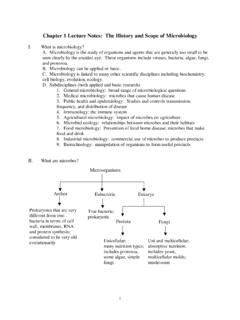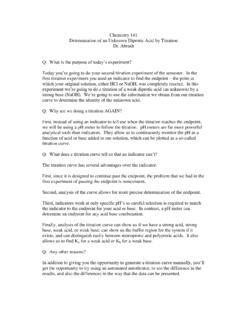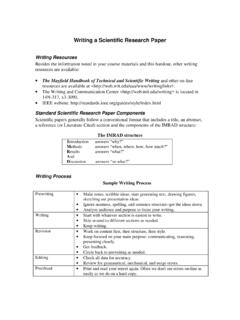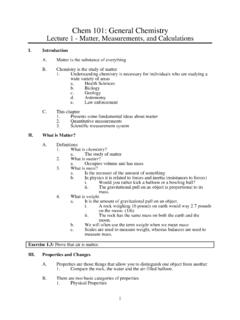Transcription of Chem 141 Titration Lab Lecture Notes - University of …
1 Chem 141 Titration Lab Lecture Notes Samuel A. Abrash Q: What is the purpose of this experiment? The purpose of this experiment is to explore two techniques by which we answer the question: How much? One technique we ll be using to answer this is weighing. The other is Titration . Q: What do we have to weigh? You re going to weigh two different substances, NaOH, sodium hydroxide, on a top loading balance, and KHP, potassium hydrogen phthalate, on an analytical balance. Q: Two different balances? What s the difference? The analytical balance is a much more precise instrument, allowing mass determinations to g. The top loading balance typically allows masses to be determined to only g. Thus the analytical balance is 100 times more precise than the top loading balance. Q: Why do we use two balances with two different precisions?
2 You need precise determination of the mass of KHP, because weighing is the only method you ll use to quantify the amount of KHP in this experiment. Therefore you want to be able to measure and record the maximum number of significant figures . It s ok to use the less precise top loading balances to find the approximate weight of the NaOH, since you ll be making a finer determination of the amount of NaOH by Titration later in the lab. Q: But why can t we just use the analytical balance to determine the exact mass of the NaOH? NaOH is a hygroscopic compound. This means that it easily absorbs water from the air. This means that the mass of any solid NaOH sample that you measure will actually be a combination of NaOH and water. Since the fraction of NaOH that you re weighing is unknown, you might as well use the less precise measuring device.
3 Q: You say we ll use Titration to determine the amount of NaOH. What s Titration ? Titration is a way of determining how many moles of a chemical are in a solution phase sample by completely reacting it with another chemical. Q: What reaction do we do to determine the number of moles of NaOH? We re reacting KHP with NaOH. The products are water and a salt. This type of reaction is called a neutralization reaction because two caustic compounds, KHP, a mild acid, and NaOH, a strong base, are replaced by water and a weaker base. Q: How much NaOH does it take to completely react with a sample of KHP? The answer to this question is based on the balanced reaction for neutralization of an acid by NaOH: 2HA NaOHNaA H O Note that in this reaction there is a 1:1 mole ratio of acid to base.
4 This equation is valid for all acids that contain only one acidic proton. All of the acids that you ll be titrating in today s experiment have just one acidic proton. This means we can write the reaction of KHP with NaOH as: 2 KHP NaOHH O NaKP Q: Why is the 1:1 mole ratio significant ? It tells us that our reaction is complete when the number of moles of NaOH that we add is equal to the number of moles of KHP that are initially present. Q: How can we tell how many moles of KHP are initially present? Since you ll have weighed out a sample of KHP, you simply divide the measured mass of the KHP by the molar mass of the KHP: mass KHPmol KHPmolar mass KHP Q: How do we determine the molar mass of the KHP? The formula of the KHP is written in the lab manual. All you need to do is multiply the number of each type of atom by its atomic mass (which you can find on the back cover of the lab manual), and then add up the total masses for each element.
5 For example, percholoric acid, with formula HClO4, has a molar mass given by /HClOmolar mass HClOx mx mx mxg mol Q: Is there a special name for the point at which we ve put equal moles of acid and base into our flask, so that the reaction is complete? We call this the endpoint of the Titration . Q: How can you tell that you ve reached the endpoint? For some reactions there is a natural color change that can be used to tell when the reaction is complete. However, for our reactions today, no color changes occur. Therefore we have two options. One is to use a device called a pH meter to determine the change in acidity as NaOH is added, and then determine the endpoint graphically. We ll do this later in the semester. The other option, the one we ll use today, is to add a compound called an indicator, which changes color when the endpoint is reached.
6 Q: What indicator will we use? Our indicator of the day is called phenolphthalein. It is clear when a solution is acidic, and turns pink when the solution turns basic. When you reach your endpoint, the next drop of base you add will make your solution basic and the solution will turn pink. Q: Will it turn bright pink? Not immediately. When you reach the endpoint, the color of your solution will be the palest pink. A bold pink indicates that you ve added too much base. Q: Once I reach the endpoint, how can I calculate the concentration of the NaOH? This is easy. You know the number of moles of NaOH, because it s the same as the number of moles of KHP. The concentration in units of molarity (moles/liter of solution) is just given by the number of moles of NaOH divided by the volume of liquid it was contained in: ()NaOHKHPNaOHNaOHnnNaOH MVV Q: How do we measure the volume of the NaOH that we ve used?
7 We use a device called a buret. I ll demonstrate the use of the buret before you begin your experiment. Q: Phew, that s a lot. So now we re done, right? Well, no. There s no way to really know how good your answer is, so you ll need to repeat it at least twice. You ll often hear scientists talk of the reproducibility of their results. The term refers in part to the ability of others to reproduce your data, and in part to your ability to reproduce your own results. Redoing the experiment is the minimum confirmation that you have correct results. Q: Do I report all three values? No. You ll report the average (or mean) of the three values. You calculate the average by adding the three values together and then dividing by three. Q: How can you tell how closely the three values agree if you re only reporting the average?
8 You can tell how close the values are by also reporting the standard deviation, a statistical measure of the precision of a group of measurements. The standard deviation is calculated with the formula: 2()1iMMsN Where Mis your average molarity, iM represents the individual measurements, and N is the total number of molarities you measured. What this really means is you take the absolute value of the difference between each of your three points and the average, square it, then add the three values up, divide by two, and take the square root. The smaller s is, the more precise your measurement is. What does it mean to be precise? Precision is a measure of the reproducibility of your measurement. This means how close repeated values are to each other. It is also a measure of how finely ruled your measurement device is, since a finely ruled device tends to be more reproducible than a crudely ruled device.
9 Is precision the same as accuracy? No! Accuracy is a measure of how close a value is to the correct value. Precision is a measure of how close repeated measurements are to each other. How can you find out how accurate a measurement is then? If a problem has been studied before, the values that are published in the literature (literature values) can be used as a measure of the true value. However, true values are usually hard to determine because new research or new techniques can result in an improvement on the published values. Q: Ok. NOW we re done, right? Not quite. At this point we ve determined the concentration of the solution of NaOH we made, a process called standardization. Now we re going to use our standardized solution to determine the concentration of acid in a commercial bottle of vinegar.
10 Q: What kind of acid is in vinegar? Acetic acid, C2H3O2H. (Only the final H is acidic.) Q: Why do we need to measure the concentration of the acid? It s right there on the bottle, 5%! One of the common tasks given to chemists is to confirm the claims made by manufacturers, whether they make cigarettes and claim that they re low in tar, or orange juice to make sure that the vitamin C content is what is claimed. For solutions, Titration is the method. Q: Uh, by the way, what does 5% acid mean? It means that 5% of the mass of the sample is acetic acid? Q: How do we find the mass percent from the molarity we determine? First you need to convert the moles of acetic acid to mass of acetic acid, but this is easy, since you just multiply the number of moles by the molar mass.










